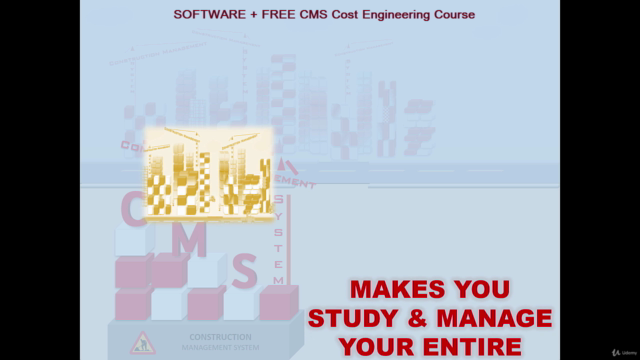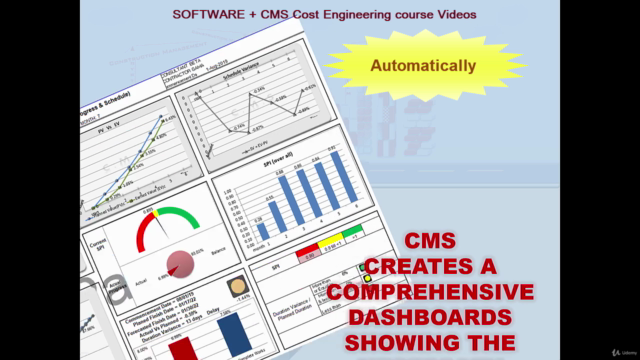Quantity Surveying, Estimation, Cost Control & CMS Software
Practical application of Quantity surveying, Estimation, Scheduling, Feasibility study; Cost Control + amazing Software
4.29 (97 reviews)

740
students
9 hours
content
Jan 2023
last update
$19.99
regular price
Why take this course?
The course description you've provided outlines a comprehensive curriculum for Quantity Surveying and Cost Engineering, which is a critical discipline within the construction industry. The course is designed to cover a wide range of topics, from understanding the standard divisions and creating detailed bills of quantities (BOQ) to cost estimation, scheduling, budgeting, feasibility studies, and cost control. Here's a breakdown of what you can expect to learn and achieve in each area:
Quantities Surveying & Activities Breakdown for:
- Division 01 — General Requirements: Understanding the general requirements for the project.
- Division 02 — Site Construction: Detailing the activities related to site preparation and construction.
- Division 03 — Concrete: Quantifying concrete works, including types, quantities, and specifications.
- Division 04 — Masonry: Estimating brickwork, stonework, blockwork, and other masonry components.
- Division 05 — Metals: Detailing metal works, such as structural steel, reinforcement bars/mesh, and metal claddings.
- Division 06 — Wood and Plastics: Quantifying timber works and plastic materials used in construction.
- Division 07 — Thermal and Moisture Protection: Estimating insulation, waterproofing, and other protective systems.
- Division 08 — Doors and Windows: Accounting for all types of doors and windows required for the project.
- Division 09 — Finishes: Detailing floor coverings, wall finishes, ceilings, and decorative elements.
- Division 10 — Specialties: Including electrical installations, plumbing, heating, ventilation, air conditioning, and other specialty trades.
- Division 11 — Equipment: Accounting for machinery and equipment needed on-site.
- Division 12 — Furnishings: Estimating costs for furniture and fixtures.
- Division 13 — Special Construction: Quantifying specialized construction activities.
- Division 14 — Conveying Systems: Estimating costs for systems that transport materials, goods, or people.
- Division 15 — Mechanical/Plumbing: Detailing mechanical and plumbing installations.
- Division 16 — Electrical: Accounting for electrical installation works.
- Division 17 — Others: Covering all other items not included in the above categories.
Detailed Materials Take-off:
- Earthworks, Excavation, Backfill, & Disposal: Quantifying excavation and backfilling activities, including disposal of materials.
- Concrete, Rebar in diameters, Shutters, Bricks & mortars, Plaster mortars, Cement, Aggregates: Detailing the quantities and types of concrete and masonry materials required.
- Tiles, Walls & Floors, Ceiling, Paints: Estimating costs for surface finishing materials.
- Water: Quantifying water supply systems.
- External Finishing: Accounting for external works.
Cost Engineering:
- Cost Coding and Actual Cost recording System: Implementing a system to track actual costs against the coded estimates.
- Earned Value Management (EVM): Understanding and applying EVM techniques for project monitoring and control.
- All Monthly Reports, Dashboards: Preparing and analyzing monthly reports, including dashboards for performance monitoring.
Additional Topics:
- Cost Control: Implementing cost control measures to maintain cost within acceptable limits.
- Construction Development Expenses: Calculating the expenses associated with construction development.
- Marketing & Selling Plan: Developing a plan for marketing and selling the project.
- Income & Out Cash flow, Net Cash flow: Analyzing the cash flow for income versus expenditure and the net result.
- Profit improvement: Identifying strategies for profit improvement.
- Optimum Land price & sharing percentage: Determining the optimal land price and the percentage of land to be shared.
Additional Methodologies:
- Cost Coding System: Implementing a system for categorizing costs.
- Earned Value Management (EVM): Understanding and applying EVM techniques for project performance monitoring and control.
- Schedule Performance Monitoring: Monitoring the progress of the project schedule.
- Resources Performance Control: Controlling the performance of resources allocated for construction projects.
- Cost Forecasting: Projecting future costs to anticipate budgetary requirements. Throughout the course, you will learn to apply these skills in real-world scenarios. The course also emphasizes the importance of adherence to professional standards and best practices within the construction industry. By completing this course, you will be well-equipped with the necessary skills and knowledge required for a career as a Quantity Surveyor or Cost Engineer.
Course Gallery




Loading charts...
3875722
udemy ID
25/02/2021
course created date
18/07/2023
course indexed date
Bot
course submited by